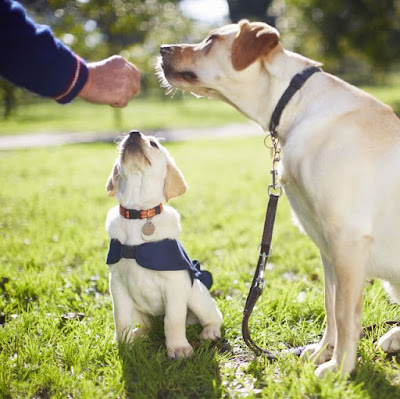Are you tired of always having to lock up your dog when guests come over? Do you have issues leaving your dog alone, even for a quick run to the grocery store? Well, there are things that you can do to help get the obedient dog that you have always wanted to have. The following tips will help you in the process of training your dog.
Dog training is not something that is easy to do properly, which means you should do your homework. Learning how to train your dog is almost as important as learning about dog behaviors and how they interact in a pack. Knowing what your dog expects from a pack leader makes training the animal much easier.
If you want to help your dog succeed in his training program, take a moment to try and think like he does. Understanding how your pet views the world can help you make better training decisions for him. The better suited your program is to your dog's personality, the more success you will have while training.
Give your puppy his own toys that he can chew to remove pain due to teething, and keep him away from chewing other items. Immediately replace it with one of his designated chew toys. Puppies sometimes chew objects while going through their teething phase. A wet cloth that has been frozen is perfect for them during this time.
Throughout your dog's training program, continue to play with them as much as possible. Interacting through games and activities is one way to bond with your pet and relieve stress. Dogs respond much better to people they trust, so go out and throw a ball, play tug of war or just rub their belly.
Stop a training session with your dog if you become angry with it. If you are angry at your dog, will not be able to train it fairly. You may be especially prone to dishing out unnecessarily harsh punishments, causing your dog to fear you rather than learn anything from that training session.
It is very easy to teach a pooch to roll over as long as you have some tasty treats on hand. You can have your dog sit or roll over. Then, position a treat near the floor to one side of him, raise it up and move it over to the opposite side. Ideally, your dog will use his nose to follow the treat, rolling his whole body in the process. When they roll over, yell "roll over." Keep doing this until they do it just with the command. Be patient with him when you are teaching this because once he learns it, he can be quite the show-off amongst your friends.
When training your dog, do it in short sessions, no more than fifteen to twenty minutes each session. This keeps your dog from becoming bored and uninterested in the training. More importantly, it ensures that your focus is entirely on training, which is vital to ensuring your dog's success.
Be ready with a favorite treat when your dog successfully completes a command. It is important for your pet to understand that you have certain expectations, what those expectations are, and that he will be rewarded for complying. This is a great way to make certain the dog grasps what is right and what is wrong.
Get in the habit of only giving your dog a direct command one time. It will seem easy to just repeat it over and over until he responds, but don't do that. Instead, revisit the training until your dog understands that you expect him to react the first time you say something.
"No" shouldn't be a huge part of training. You must find positive methods to reinforce your commands when training a dog. When you say "no", your dog does not understand how to react. Every situation and dog is different and their training should be tailored accordingly.
A great dog training tip is to assume the role of the pack leader. All dogs have a pack mentality. There is typically a pack leader that influences the behavior of the rest of the pack. By acting as the pack leader, your dog will become more obedient.
Never treat your dog as a person. Many pet owners coddle their dogs as if they were children, and this only confuses your pet. Training a dog is completely different than teaching a child. Dogs need to be taught to behave as a dog and expect you to behave as a dog as well when it is necessary.
As was stated in this article, it is possible to have a wonderful dog that you can be proud of. You just have to know the right techniques, in order to do that. Do not waste any more time and begin by putting these great tips to use. You will not recognize your dog when you are done.




